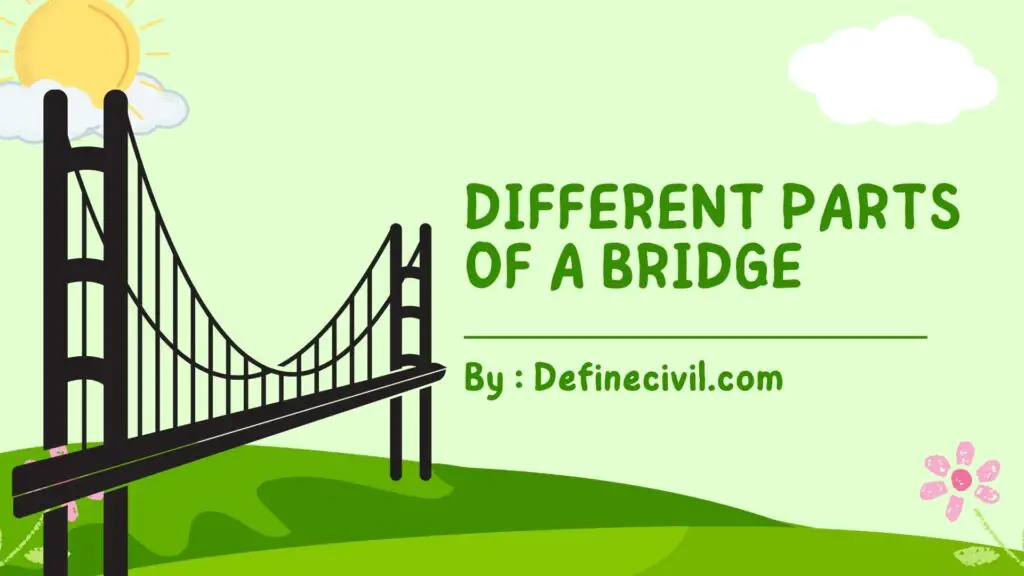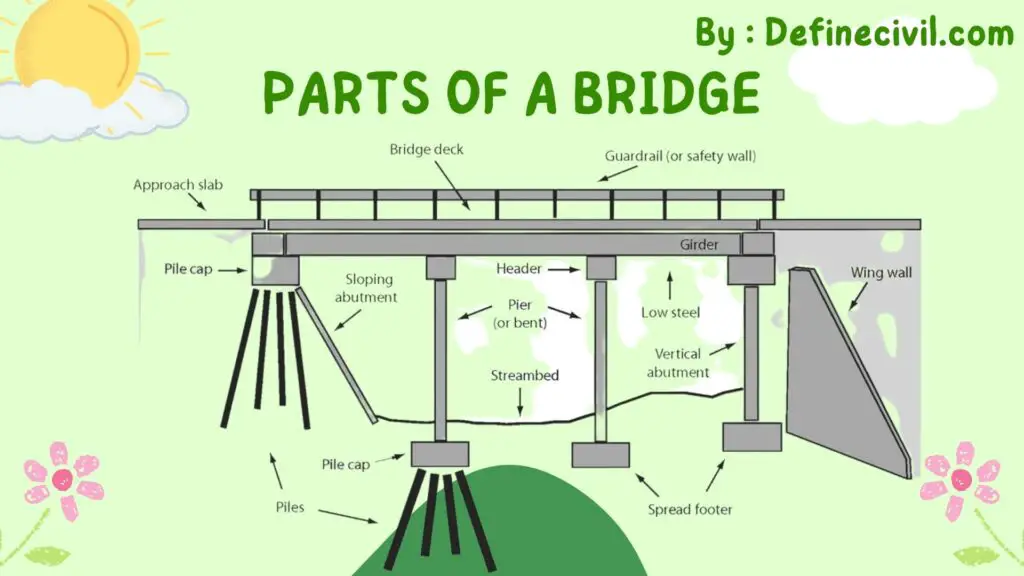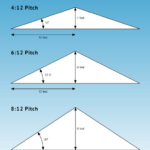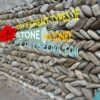Before you start building a bridge, it’s important to understand the different parts of the structure and how they work together to support the bridge and hold up traffic and people above the river or valley below.
There are many different parts that can be combined in various ways, depending on the type of bridge being built, but no matter what, every bridge has at least one of these components: piers, abutments, struts, arches and decking.
How different parts of bridge work together?
A structure which spans horizontally between supports and is built to provide passage across a river, stream, road, or any other physical obstruction, is called a bridge. The span of a bridge is limited because of high deflections induced under loads.
Also Read: Difference between Bridge and Culvert
However, longer spans can be achieved by providing strong foundations and using innovative techniques such as prestressing. There are various types of bridges used in different conditions.
Factors which primarily govern the selection of a particular type of bridge are; topography of the area, desired span length, loads acting, material used, and funds available. Different types of bridges are briefly discussed below. The main focus of this article will be on the components of a bridge.

Arch Bridge
As the name implies, this bridge is in the shape of an arch and arch phenomenon is used to transfer loads. This bridge is curved in shape and loads are not applied directly downwards, instead loads are carried through the curved portion to the end supports called abutments. From abutments, loads are carried to the ground.
Beam Bridge
Beam bridges consist of heavy beams which are supported on piers. These beams are simply supported on supports. Loads are transferred through the beams to the supports and are finally carried to the ground.
Truss Bridge
A truss bridge is constructed by a framework of interconnected trusses which are usually triangular in shape. Trusses are rigid, lightweight, and can transfer heavy loads.
Also Read: What is a truss?- Types of Trusses
Suspension Bridge
This type of bridge is constructed by suspending deck slab with suspension cables. These cables are connected to towers and secured by anchors on both sides of the deck slab. These anchorages are made up of massive concrete blocks. A truss arrangement is provided underneath the deck slab to stiffen the overall structure. Longer spans can be achieved using suspension bridges.
Cable-Stayed Bridge
Cable stayed bridges are similar to suspension bridges except the arrangement that cables are directly connected to the towers without suspension cables. This is a modern bridge design. Longer spans are achieved using this type of bridge.
Now we will discuss about components of a bridge.

Parts of a bridge
Broadly speaking, a bridge is divided into two parts i.e. superstructure and substructure. Anything from girders to the above falls under superstructure, and all parts below the bottom of girders are components of substructure.
Superstructure Components
Girders
The beams which support the deck slab and carry loads to the structure below are called girders. These beams are usually simply supported at edges. Girders can be made of steel, wood, or concrete. These days reinforced cement concrete girders are commonly used. Furthermore, beams are pre-stressed to increase their serviceability. Usually, post tensioning is used because it is comparatively easier and economical method, and also prestress losses are minimum.
Deck Slab
Deck slab is that structural component of superstructure which carries loads and transfers them to beams below. It forms the surface of bridge. Pavement or railway are provided on deck slab. It is usually constructed of reinforced cement concrete. Pavement surfacing or railway lines are provided on the surface of deck slab.
Arches and Cables
Both arches and cables are used in specific conditions. Arches are used in the construction of arch bridges and cables are used in the construction of suspension and cable stayed bridges. All these bridge types have already been discussed above.
Trusses
Trusses are used in truss bridges. Truss forms an essential part of such bridges. These are used due to their high rigidity, light weight, and ability to safely carry heavy loads. A truss transfers loads from a single point to a much wider area.
Parapet Walls
Parapet walls are constructed on sides of a bridge for the safety of vehicles plying on it.
Bearings
Bearings are used at the point where beams are joined to substructure. It is not feasible to transfer loads from superstructure directly to the substructure because it will cause wear and tear at the point of connection.
Therefore, bearings are installed between beams and piers which safely carry loads to the substructure. Bearings do not only carry vertical loads but transfer longitudinal loads also.
These can also be used to offset expansion and contraction caused by temperature variation in bridges. Different types of bearings are available and selection depends on design of bridge, anticipated displacements and rotations, material used, etc. Elastomeric bearings are popular nowadays.
Substructure Components
Pier Cap
A pier cap is a thick concrete slab that is placed at the top of piers and constructed monolithically with the piers. It holds the bridge girders on bearing pads and transfers loads from bearings to piers. It also ensures uniform load distribution. It is also known as headstock or header.
Piers
Load from superstructure is transferred through piers cap to piers. Pier is a vertical load bearing member which is usually made of RCC in case of bridges. The shape of pier is usually circular. A number of piers can be used under a pier cap depending on design requirements.
Pile Cap
A pile cap does the same function as that of a pier cap. The difference is that pile cap is provided over piles to group them together and carry loads from piers to piles.
Piles
Piles fall under the category of deep foundation. They are formed by long, slender, columnar elements typically made of concrete, steel or in some cases wood. They transfer loads either through end bearing or skin friction. Piles are the final load transferring elements in substructure of a bridge.
Also Read: What is pile foundation? 9 Types of Pile Foundation (Must Know)
Abutments
Abutments are provided at the start at end point of a bridge. These are end supports and a bridge always starts from and terminates at an abutment. A beam seat is provide on abutment to place the beam in position. Apart from carrying vertical loads, abutments also carry lateral loads. In addition to that, they also resist backfill pressure due to soil. The essential components of an abutment include a back wall, stem, footing, and beam seat.
Wing Walls and Returns
Wing walls are provided on both sides of an abutment. These are provided to resist earth pressure due to backfill, resist hydraulic pressure if the soil is saturated, and resist surcharge load, if any.
Further Read: Parts of Stair – Components of a staircase – Diagram – Railing – Details



















